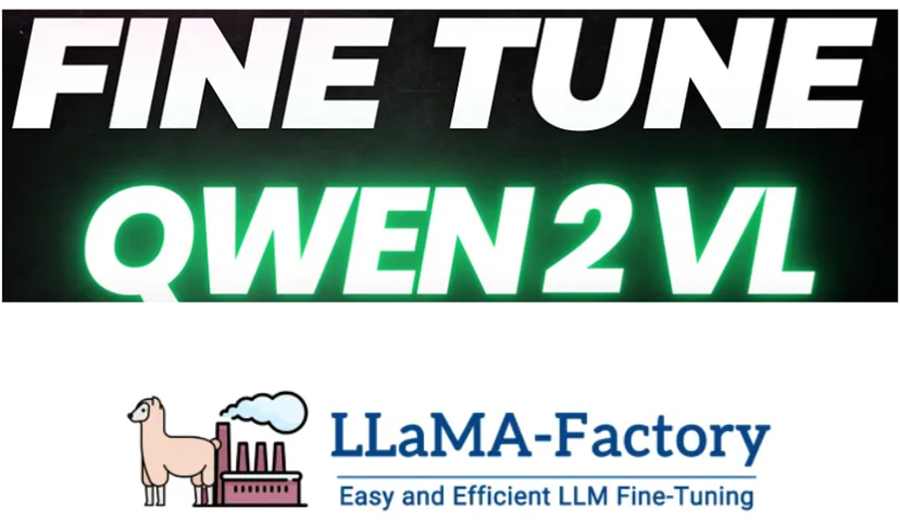用LlamaFactory微调Qwen-2 VL
在这篇博文中,我们将探索如何使用 LlamaFactory 框架微调多模态大模型Qwen-2 VL。

在这篇博文中,我们将探索如何使用 LlamaFactory 框架微调多模态大模型Qwen-2 VL。无论你是经验丰富的 AI 开发人员还是刚刚起步,本指南都将为你提供定制 Qwen-2 VL 以满足你的特定需求的知识。
1、Qwen-2 VL:多模态冠军
在我们进入微调过程之前,让我们花点时间来欣赏这个惊人模型的功能。
- 开源:这意味着它可供所有人免费使用和修改,促进 AI 社区内的创新和协作。
- 紧凑尺寸:与许多需要大量计算资源的大型语言模型 (LLM) 不同,Qwen-2 VL 非常紧凑,个人和资源有限的小型团队都可以使用它。
- 多模态:能够同时处理文本和图像,使 Qwen-2 VL 能够处理各种任务,从图像字幕到视觉问答。
2、LlamaFactory:微调的简便方法
微调是将预训练模型调整为特定任务的过程。这对于提高模型的性能和实现最佳结果至关重要。LlamaFactory 通过其用户友好的界面和强大的功能简化了此过程。
LlamaFactory 就像拥有一个装满 AI 魔法工具的工具箱,让你可以:
- 微调各种 AI 模型:从 LLM 到 Qwen-2 VL 等多模态模型。
- 使用“低代码”或“无代码”方法:这意味着你不必是编码专家即可开始使用。
- 为特定任务自定义模型:训练你的模型以进行图像字幕、文本摘要或你能想到的任何其他任务。
用LlamaFactory 微调 Qwen-2 VL 模型有两种主要方法:
- LlamaBoard:无代码方法
LlamaBoard 是一个可视化、用户友好的界面,让您无需编写一行代码即可微调模型。它非常适合初学者和那些喜欢更直观方法的人。
- LlamaFactory CLI:命令行灵活性
LlamaFactory CLI 通过命令行命令提供更大的灵活性和对微调过程的控制。这对于想要尝试各种参数和设置的有经验的用户来说是理想的选择。
3、入门:设置你的环境
让我们为微调冒险做好准备:
- Google Colab Pro:你需要访问 Google Colab Pro 以获得必要的计算资源。免费的 Colab 无法完成这项任务!
- 克隆 LlamaFactory:使用
git clone从 GitHub 下载 LlamaFactory 存储库。 - 安装依赖项:通过运行
pip install -r requirements.txt确保你拥有所有必需的软件包。 - 准备数据:收集你将用于微调模型的文本和图像数据。
!git clone https://github.com/hiyouga/LLaMA-Factory.git
%cd LLaMA-Factory
!pip install -r requirements.txt
!pip install bitsandbytes
!pip install git+https://github.com/huggingface/transformers.git
!pip install -e ".[torch, metrics]"
!pip install liger-kernel3.1 Llama Board
import os
!GRADIO_SHARE=1 llamafactory-cli webui
4、微调过程:分步指南
对于这篇博文,我们将重点介绍 LlamaFactory CLI 方法,但 LlamaBoard 的步骤类似。
- 创建配置文件 (JSON)
首先创建一个 JSON 文件,概述微调过程的参数。这包括你正在使用的模型、数据集和所需的训练设置等内容。
- 启动微调过程
使用 llama_factory train 命令,将路径传递到你的 JSON 配置文件。
- 监控训练
观察微调过程的输出和进度。这将让你深入了解模型的学习方式。
- 合并微调模型
训练完成后,你可以使用 LlamaFactory 中提供的 merge_adapter 函数将微调模型与原始模型合并。
- 测试和部署
最后,评估微调模型的性能并将其部署到您的应用程序中。
5、Llama Factory CLI
import json
args = dict(
stage="sft", # do supervised fine-tuning
do_train=True,
model_name_or_path="Qwen/Qwen2-VL-2B-Instruct", # use bnb-4bit-quantized Llama-3-8B-Instruct model
dataset="mllm_demo,identity", # use alpaca and identity datasets
template="qwen2_vl", # use llama3 prompt template
finetuning_type="lora", # use LoRA adapters to save memory
lora_target="all", # attach LoRA adapters to all linear layers
output_dir="qwen2vl_lora", # the path to save LoRA adapters
per_device_train_batch_size=2, # the batch size
gradient_accumulation_steps=4, # the gradient accumulation steps
lr_scheduler_type="cosine", # use cosine learning rate scheduler
logging_steps=10, # log every 10 steps
warmup_ratio=0.1, # use warmup scheduler
save_steps=1000, # save checkpoint every 1000 steps
learning_rate=5e-5, # the learning rate
num_train_epochs=3.0, # the epochs of training
max_samples=500, # use 500 examples in each dataset
max_grad_norm=1.0, # clip gradient norm to 1.0
loraplus_lr_ratio=16.0, # use LoRA+ algorithm with lambda=16.0
fp16=True, # use float16 mixed precision training
use_liger_kernel=True, # use liger kernel for efficient training
)
json.dump(args, open("train_qwen2vl.json", "w", encoding="utf-8"), indent=2)
!llamafactory-cli train train_qwen2vl.json
args = dict(
model_name_or_path="Qwen/Qwen2-VL-2B-Instruct", # use official non-quantized Llama-3-8B-Instruct model
adapter_name_or_path="qwen2vl_lora", # load the saved LoRA adapters
template="qwen2_vl", # same to the one in training
finetuning_type="lora", # same to the one in training
export_dir="qwen2vl_2b_instruct_lora_merged", # the path to save the merged model
export_size=2, # the file shard size (in GB) of the merged model
export_device="cpu", # the device used in export, can be chosen from `cpu` and `cuda`
#export_hub_model_id="your_id/your_model", # the Hugging Face hub ID to upload model
)
json.dump(args, open("merge_qwen2vl.json", "w", encoding="utf-8"), indent=2)
%cd /content/LLaMA-Factory/
!llamafactory-cli export merge_qwen2vl.json
final_model_path = "/content/LLaMA-Factory/qwen2vl_2b_instruct_lora_merged"
hf_model_repo = "skuma307/Qwen2-VL-2B-Instruct-LoRA-FT"
from huggingface_hub import notebook_login
notebook_login()
from huggingface_hub import HfApi, HfFolder, Repository
# Create an instance of HfApi
api = HfApi()
api.upload_folder(
folder_path=final_model_path, # The folder containing the model files
repo_id=hf_model_repo, # Your authentication token
commit_message="Initial model upload" # Optional commit message
)
print(f"Model pushed to: {hf_model_repo}")故障排除:常见错误及其解决方法
- GPU 内存问题:如果遇到内存不足错误,请尝试清理缓存、释放 GPU 内存或减小批处理大小。
- 缺少依赖项:仔细检查是否安装了所有必要的依赖项。
- 数据格式问题:确保你的数据格式正确且与 LlamaFactory 兼容。
7、结束语:微调的力量
使用 LlamaFactory 对 Qwen-2 VL 等多模态模型进行微调开辟了无限可能。它允许你针对特定任务自定义模型的功能,从而提高准确性和性能。
别忘了查看 LlamaFactory GitHub 存储库,你将找到全面的文档、代码示例和有用的资源。
原文链接:Fine-Tuning the Multimodal Marvel: Qwen-2 VL with LlamaFactory
汇智网翻译整理,转载请标明出处